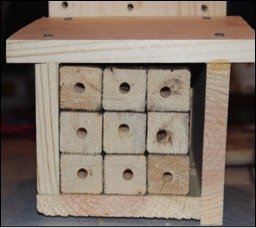Mason Bee Monitoring Project
This project has ended. Information is provided here for historical purposes.
 Bee hotel
Bee hotel
The Mason Bee Monitoring Project is a research initiative started to help researchers at the University of Virginia Department of Environmental Sciences understand more about a group of bees called mason bees (genus Osmia). We have around 20 species of springtime mason bees in the Mid-Atlantic United States, and the goal of the study is to learn more about how two recently-introduced exotic mason bee species may be impacting the native mason bee community in Virginia.
In total, over 200 citizen scientists contributed to data collection from 2017-2019, with many of these citizen scientists participating through chapters of the Virginia Master Naturalist Program (27 chapters, to be exact: Alleghany Highlands, Arlington Regional, Banshee Reeks, Beagle Ridge, Blue Ridge Foothills and Lakes, Central Blue Ridge, Central Rappahannock, Central Virginia, Eastern Shore, Fairfax, Headwaters, High Knob, Historic Rivers, Historic Southside, Holston Rivers, James River, Merrimac Farm, Middle Peninsula, New River Valley, Northern Neck, Old Rag, Pocahontas, Rivanna, Riverine, Roanoke Valley, Shenandoah, and Southwestern Piedmont).
With all of the citizen scientists who helped us monitor mason bee communities on private and public lands, we are able to discover in great detail the diversity of the mason bee community, we’re documenting exotic fungal diseases in the exotic mason bees and how these diseases have now spread over to native mason bees. We are also learning more about how climate and elevation across Virginia impact how far these exotic mason bees can spread across the Commonwealth of Virginia and further into North America.
A recent publication shares some of the project findings: LeCroy, K.A., Savoy-Burke, G., Carr, D.E. et al. Decline of six native mason bee species following the arrival of an exotic congener. Sci Rep 10, 18745 (2020). https://doi.org/10.1038/s41598-020-75566-9
In total, over 200 citizen scientists contributed to data collection from 2017-2019, with many of these citizen scientists participating through chapters of the Virginia Master Naturalist Program (27 chapters, to be exact: Alleghany Highlands, Arlington Regional, Banshee Reeks, Beagle Ridge, Blue Ridge Foothills and Lakes, Central Blue Ridge, Central Rappahannock, Central Virginia, Eastern Shore, Fairfax, Headwaters, High Knob, Historic Rivers, Historic Southside, Holston Rivers, James River, Merrimac Farm, Middle Peninsula, New River Valley, Northern Neck, Old Rag, Pocahontas, Rivanna, Riverine, Roanoke Valley, Shenandoah, and Southwestern Piedmont).
With all of the citizen scientists who helped us monitor mason bee communities on private and public lands, we are able to discover in great detail the diversity of the mason bee community, we’re documenting exotic fungal diseases in the exotic mason bees and how these diseases have now spread over to native mason bees. We are also learning more about how climate and elevation across Virginia impact how far these exotic mason bees can spread across the Commonwealth of Virginia and further into North America.
A recent publication shares some of the project findings: LeCroy, K.A., Savoy-Burke, G., Carr, D.E. et al. Decline of six native mason bee species following the arrival of an exotic congener. Sci Rep 10, 18745 (2020). https://doi.org/10.1038/s41598-020-75566-9
Project Timeline
The Mason Bee Monitoring Project has completed the data collection phase (2017-2019) and we are underway with the next phase: data processing and analysis. Researchers are now cataloging three years of data from many locations (see maps). We plan to share reports with our citizen scientist participants based on the projected timeline below (amended to consider disruptions to research due to the COVID-19 pandemic). If you have any questions, or if you’re interested in keeping up with the progress of data processing and analysis, feel free to reach out to Kate LeCroy at: masonbeemonitoring @ gmail.com and she’ll be happy to update you!
The Mason Bee Monitoring Project has completed the data collection phase (2017-2019) and we are underway with the next phase: data processing and analysis. Researchers are now cataloging three years of data from many locations (see maps). We plan to share reports with our citizen scientist participants based on the projected timeline below (amended to consider disruptions to research due to the COVID-19 pandemic). If you have any questions, or if you’re interested in keeping up with the progress of data processing and analysis, feel free to reach out to Kate LeCroy at: masonbeemonitoring @ gmail.com and she’ll be happy to update you!
Research Description |
Data Processing |
Reporting to Citizen Scientists |
Native mason bee declines and exotic mason bee surges |
Completed |
September 2020 |
Novel exotic fungal infections in native mason bees |
Completed |
December 2020 |
How climate restricts exotic mason bee spread |
Completed by early Spring 2020 |
April 2021 |
Differential enemy attack on native and exotic mason bees |
Completed by Summer 2020 |
August 2021 |
Project Leaders and Contacts
Kathryn (Kate) LeCroy, Graduate Student, University of Virginia, [email protected]
T’ai Roulston, Research Assoc. Professor, Environmental Science, University of Virginia, [email protected] (540-837-1758, ext. 276)
Kathryn (Kate) LeCroy, Graduate Student, University of Virginia, [email protected]
T’ai Roulston, Research Assoc. Professor, Environmental Science, University of Virginia, [email protected] (540-837-1758, ext. 276)
Project Resources

